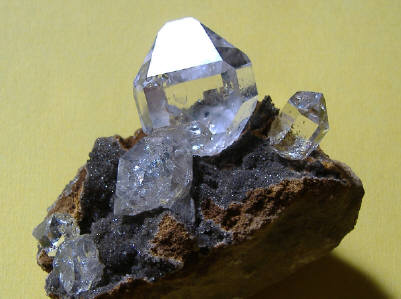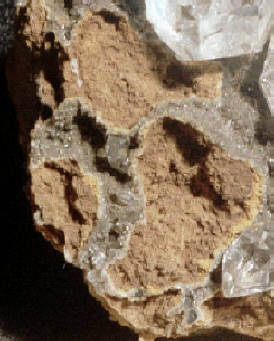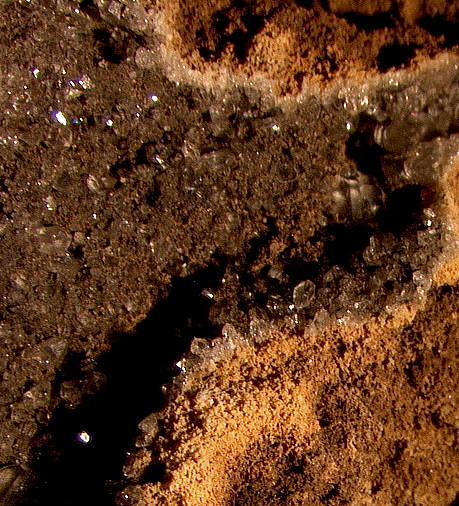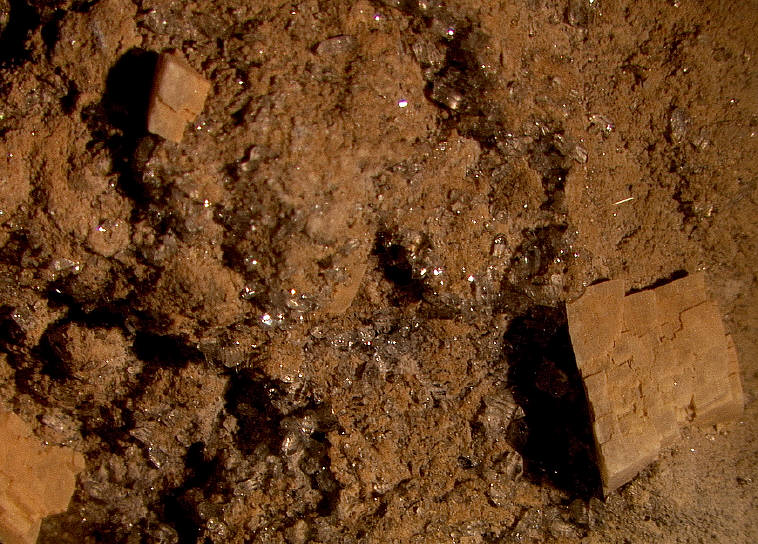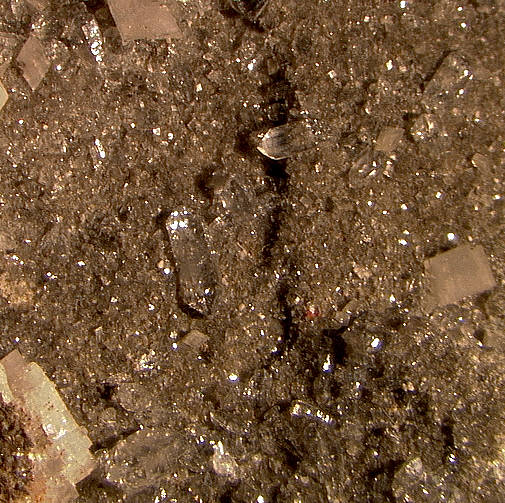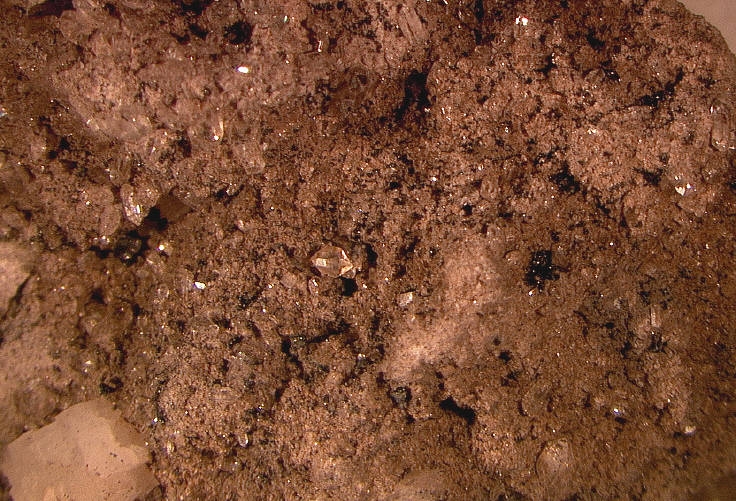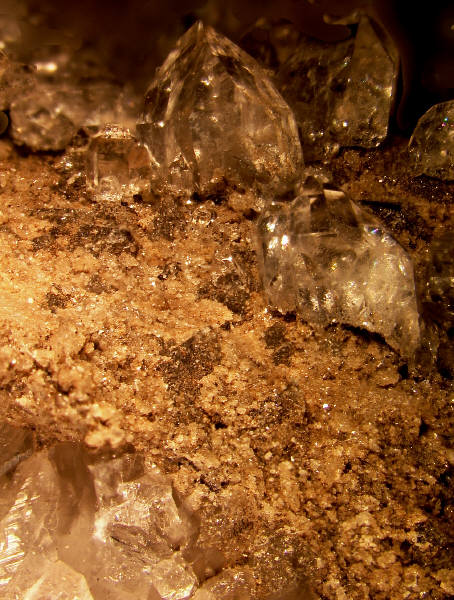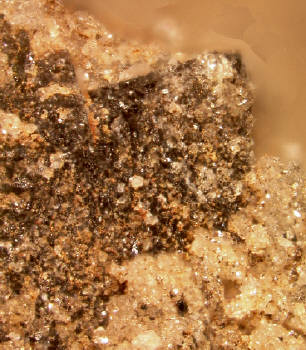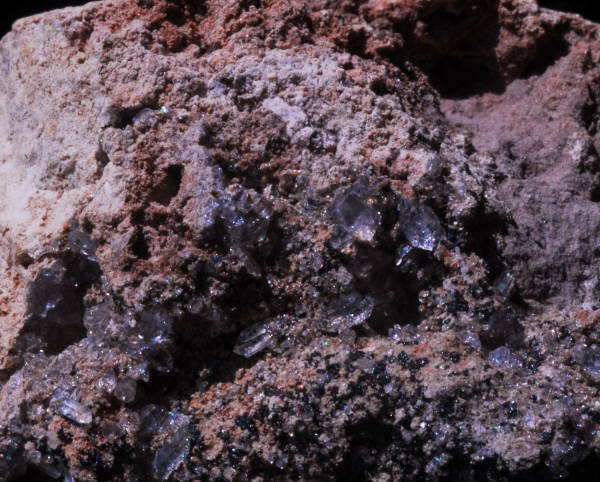This site was last updated on June, 2010
Quartz Crystal Habits within Herkimer Diamond Deposits
The best website on "Herkimer Diamonds"
Larger photos of the thumbnails presented on the main "Crystal Form" page. Included is identification information and the source link is embedded there (just click). In some cases additional information and comments are provided for each photo.
The "baby floater" druze refers to a unique stage of mineralization in the Herkimer mining district. It is a "druze", or coating, of very small (sometimes microscopic), Herkimer diamonds. It seems to occur in every mine, and at the same place in the mineral sequence , just before the major Herkimer diamond event.
Please help with picture donations!
A public service project always open to input from the community interested in Herkimer diamonds.
There are many features associated with it that are illustrated below. See also the inclusion page ------->
On the left, this specimen ( 9 cm across) from Fonda, NY (DA) that shows a different type of druze. it is here named "baby floater druze" because it appears to be a coating of microsopic Herkimer diamonds. The specimen is described more on the matrix (host rock) page (click on link below).
A close up on this specimen (below) is from where the black arrow is pointing (sepcimen upper left) and shows an interesting feature. The druze used to be covering more rock but is now gone and the exposed rock is very eroded (probably a hydrothermal effect connected to the baby floater event, as we see this in other mines). An important point to consider - if this was the wall rock of larger pockets it would be quite unstable. Given this to be the case, then much of the wall rock would show collapse and be found with the mud at the bottom. See the link to mud discussion ->
<--- "Baby floater druze"
Please visit the inclusions page to see more "baby floater" pictures as inclusions inside Herkimer diamonds. This particular druze may hold a key piece of the Herkimer diamond story.
On the left is a microscope close up of the above, on the edges of the "cavities". The druze does not look like any other druze. There is not a thick layer (or rind) between the quartz and the host rock, just a microscopic rind. The druze doesn't form the same crystal pattern of "mountain peaks" but instead is a coating of microsopic Herkimer Diamond like crystals randomly scattered. Photos, Dr.D, 2009
The microscope photo to the left shows a light coating of microscopic Herkimer Diamond like crystals on fresh matrix of very tiny, nearly clear, rhombs of dolomite. The blocky crystal in the middle right is dolomite just 1 mm across. From the Hanson/Benchmark Quarry , St. Johnsville, NY. Photo, Dr. D. (Specimen donated by Mike Eggleston).
The microscope photo below shows a light coating of microscopic Herkimer Diamond like crystals on an "eroded" matrix. The blocky crystals are dolomite. From Herkimer Diamond Mine, Middleville, NY. Photo, Dr. D. The largest dolomite is only 2 mm across.
Microscope photo below shows a light coating of microscopic Herkimer Diamond like crystals on an "eroded" matrix, a bit more eroded that the rock in the above photo. The blocky crystal in the lower left is dolomite just 2 mm across. From the top of a Herkimer pocket at the Ace of Diamonds Mine, Middleville, NY. Photo, Dr. D., 2009 (Specimen donated by Bill and Anne).
Web page author - W. David Hoisington, Ph.D.
Another specimen showing this unique druze of microscopic Herkimer Diamond like crystals is shown below. It is also from Fonda. NY (DA). In this specimen the baby floater druze is coating the pyramidal druze (labeld with an arrow and a P).
The mountain peaks of the druze can be seen poking out above the baby floater druze layer. Herkimer diamonds are on top of the baby floater druze. (photo DrD, 2009)
Below is a close-up of the pyramidal druze point located at the arrow labeled P (left photo). This pyramidal point is only one mm wide at its base. The white sparkling speckles coating the point and all along its base are the baby floater druze made of hundreds of crystals. So you can see how tiny this baby floater stage can get. (photo DrD, 2009)
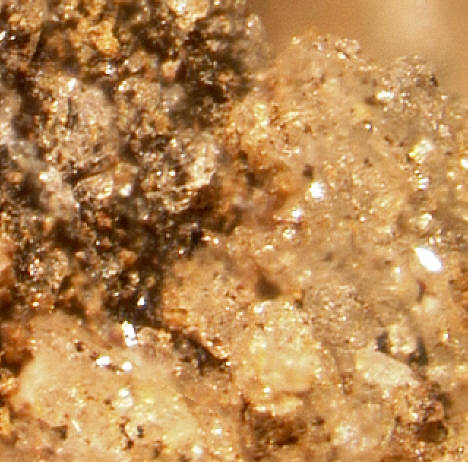
In the photo on the right you can see some of the flat faces of the tiny Hermimer diamonds and you can see how they are piled on top of each other in a random pattern. These crystals are very tiny, but it is interesting to note that in this one specimen (see above) the coating has literally thousands of crystals.
Imagine that a solution is moving through the porous rock containing these microscopic "baby floaters", many probably smaller than shown in these photographs. Some will serve as seeds for larger crystals, some will stay in solution, some will get caught up in the carbon material, and some will disolve (we have seen examples of what are locally called "ghost inclusions").
The arrow (above) shows where the close-up below is taken. The entire photo here is only one mm across.
Although we are just begining to examine the "baby floater" druze event in more detail, the evidence to date suggests that it is probably the most important event in terms of its connection to both the formation of larger Herkimer diamonds and its contribution to the overall eroded nature of non-druze zone pockets. This druze can be seen over "normal druze" and sometimes there is pitting and etching of the underlying druze, and/or a second coating. But its most dramatic effect was probably in the large pocket zones that did not have an earlier druze coating.
It may be that the baby floater event served as "seed" crystals for the Herkimer diamond event, and if so this overcomes the difficulty of growing crystals on dolomite or in carbon material. This particular druze may hold a key piece of the Herkimer diamond story, but there is still more research that needs to be done. And like most research, the more we discover the more questions we find.
There is another photo of wall rock from a Herkimer pocket at the Ace of Diamonds Mine on the "mud" page ------------>
The photo to the left is taken using a macro lens. Distance across the photo is 4 cm. The specimen was collected at TCR with permission from the owner. It is a fairly "ugly" specimen, but it shows a light coating of tiny Herkimer Diamond like crystals on very eroded matrix of dolomite (no underlying druze). The matrix shows more "erosion" than the other photos above. There is black carbon material at the bottom along with "rust". Photo, Dr. D., 2010.
